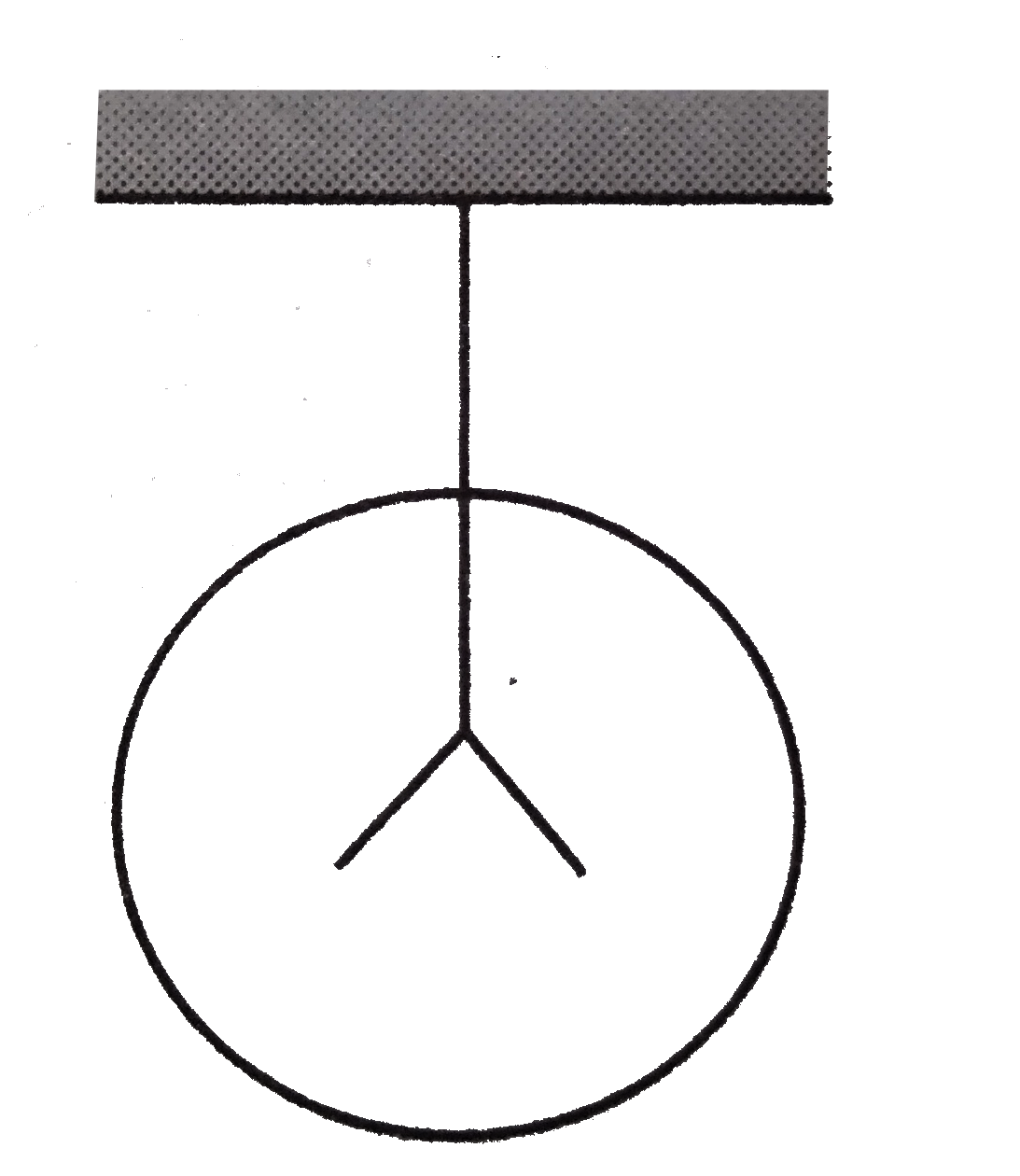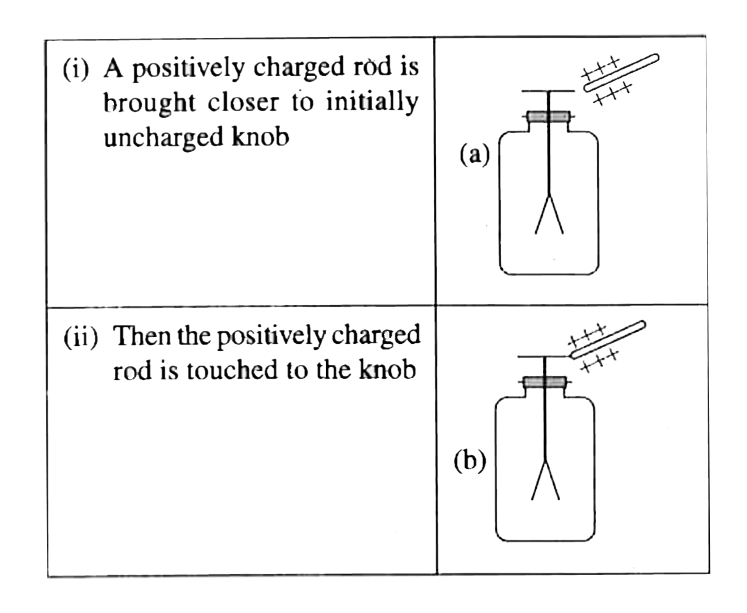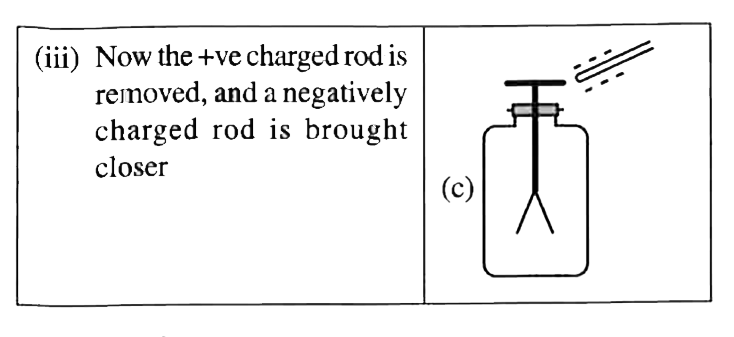A positively charged rod is brought near to a non-conducting object. The rod is attracted to the object. From this observation. We can't predict whether the object is charged or uncharged. Some additional experments have been performed to identify whether the object is charged or uncharged, these experiments with their observations and conclusions drawn are given. Select the option in which conclusion drawn is correct.
A negatively charged rod is brought near to object and the two attract, this shows that the object is neutral.
A negatively charged rod is brought near to object and two repel, this shows that the object is negatively charged.
A neutral rod is brought near to object and two attract, this shows that the object is negatively charged.
All of the above
The correct Answer is:D
Step by step video, text & image solution for A positively charged rod is brought near to a non-conducting object. The rod is attracted to the object. From this observation. We can't predict whether the object is charged or uncharged. Some additional experments have been performed to identify whether the object is charged or uncharged, these experiments with their observations and conclusions drawn are given. Select the option in which conclusion drawn is correct. by Physics experts to help you in doubts & scoring excellent marks in Class 12 exams.
Topper's Solved these Questions
- BOOK - CENGAGE PHYSICSCHAPTER - COULOMB LAW AND ELECTRIC FIELDEXERCISE - Multiple Correct Answers Type2videos
COULOMB LAW AND ELECTRIC FIELD
- BOOK - CENGAGE PHYSICSCHAPTER - COULOMB LAW AND ELECTRIC FIELDEXERCISE - Comprehension Type2videos
COULOMB LAW AND ELECTRIC FIELD
- BOOK - CENGAGE PHYSICSCHAPTER - COULOMB LAW AND ELECTRIC FIELDEXERCISE - Integer8videos
COULOMB LAW AND ELECTRIC FIELD
- BOOK - CENGAGE PHYSICSCHAPTER - COMMUNICATION SYSTEMEXERCISE - QUESTION BANK19videos
COMMUNICATION SYSTEM
- BOOK - CENGAGE PHYSICSCHAPTER - Current ElectricityEXERCISE - QUESTION BANK40videos
Current Electricity
Similar Questions
Akshay and Sauranh are the students of class IX. They have recently studied the chapter on structure of atom in the class. Both Akshy and Saurabh were performing some activities in the science laboratory. Akshy took a plastic comb and rubbed it in his dry hair. When he brought this plastic comb (rubbed in dry hair) near tiny pieces of paper, the comb attracted the pieces of paper towards it. Mean while, Saurabh took a glass rod and rubbed it with a piece of silk cloth. When he brought this glass rod (rubbed with silk cloth) near the tiny pieces of paper, the glass rod also attracted the pieces of paper towards it (just like the plastic comb). Akshy and Saurabh had studied an instrument called electroscope in class VIII. So, they decided to make use of a positively charged electroscope having diverged leaves (or opened up leaves) in their activity. Akshy took the plastic comb (rubbed in dry hair) and touched the metal top of positively charged electroscope with it. This made the diverged leaves of electroscope to fold up. Saurabh then tool the glass rod (rubbed with silk cloth) and touched the metal top of another positively charged electroscope with it. This made the diverged leaves of the electroscope to diverge (or open up) even more. Askshy did not understand the various conclusions which could be drawn from all these observations. Saurabh explained him everthing very clearly.
(a) What conclusion can be drawn from the observation that a plastic comb rubbed in dry hair and a glass rod rubbed with silk cloth, both attract tiny pieces of paper ?
(b) What do the above observations tell us about the atoms present on plastic comb and glass rod ?
(c) (i) What conclusion do you get from the observation that when a plastic comb rubbed in dry hair is touched with the metal top of a positively charged electroscope, then its diverged leaves fold up ?
(ii) What conclusion do you get form the observation that when a glass rod rubbed with silk cloth is touched with the metal top of a positvely charged electrosope, then its leaves diverage even more ?
(d) What are the two types of electric charges present in atoms as shown by the above observations ? Name the subatomic particles which carry these charges.
(e) (i) Which electric charges are agained by a plastic comb on rubbing in dry hair ?
(ii) Which electric charge are lost by a glass rod on rubbing with silk cloth ?
(f) What values are displayed by Saurabh in this episode ?View SolutionAs is known, all mater is made up of atoms/molecules. Every atom consits of a central of a central core, called the atomic nucleus, around which negatvely charged electrons revole in ciruclar orbits. Every atom is electrically neutral. Containing as many electron as the number of protons in the nucleas.
Thus, even though normally, the materails are electrically neutral, they do contains charges, but thier charges are exactly balanced. The vast amount of charge in an object is usually hidden as the object is usually hidden as the object is said to be electracally neutral charge. With such an equality or balance of charges the object is said to be electrically neutral or uncharged. To electrify or charge a neutral body, actully transfer to the other body. The body which gains electrons become negatively charged and the body which loses electrons becomes positivelyh charged. Further, like charges repel adn unlike charges attract.
Read the above passage and answer the following questions :
(i) Every body, whether a conductor or an insulator is electrically neutral. Is it true ?
(ii) Charging lies in charge imbalance, i.e, excess charge, comment.
(iii) How do you visualize this principle being applied in our daily life ?View Solution
Knowledge Check
- Question 1 - Select One
A neural (uncharged) metal ball is suspended using a non-magnetic string. A positively charged insulating rod is placed near the ball which is observed to be attracted to the rod. This is because
Athe ball becomes positively charged by inductionBthe ball becomes negatively charged by inductionCthere is a rearrangement of the electrons in the ballDthe number of electrons in the ball is more than the number of electrons on the rod - Question 2 - Select One
A solid conducting object with a non-uniform curvature is given a charge Q. Select the correct option.
ACharge will be uniformly distributed on its outer surfaceBCharge will be uniformly distributed over its volumeCCharge will be non-uniformly distributed over its outer surface with more concentration of charge where the radius of curvature is smallDCharge will be non-uniformly distributed over its outer surface with more concentration of charge where the radius of curvature is large - Question 3 - Select One
An electroscope is given a positive charge, causing its foil leaves to separate. When an object is brought near the top plate of electroscope, the foils separate even further. We conclude
 Athat the object is positively charges.Bthat the object is electrically neutral.Cthat the object is negatively charged.Dnone of these
Athat the object is positively charges.Bthat the object is electrically neutral.Cthat the object is negatively charged.Dnone of these
An electroscope is given a positive charge, causing its foil leaves to separate. When an object is brought near the top plate of the electroscope, the fiols separated even further. We conclude.
 View Solution
View SolutionA leaf electroscope is a simple apparatus to detect any charge on a body. It consist of two metal leaves OA and OB, free to rotate about O. Initially both are very slighty separted. When a charged object is touched to the metal knob at the top of the conduction re, charge flows from knob to the top of the conduction rod, charge flows from knob to the leaves through the conducting rod, charge flows from knob to the leaves through the conduction rod. As the leaves are now charged similarly, they start repelling each other and tet separted (deflected by certain angle).

The angle of deflection in static equilibrium is an indicator of the amount of charge on the charged boy.
If we perform these steps one by one.


In which case, the leaves will converge (come closer), as compared to the previous state?View SolutionLearning is the knowledge of that which is not generally known to others, and which we can only derive at secondhand from books or other artificial sources. The knowledge of that which is before us, or about us, which appeals to ULU' experience, passions, and pursuits, to the bosoms and businesses of men, is not learning.
Learning is the knowledge of that which none but the learned know. He is the most learned man who knows the most of what is farthest removed from common life and actual observation. The learned man prides himself in the knowledge of names, and dates, not of men or things. He thinks and cares nothing about his next-door neighbours. but he is deeply read in the tribes and castes of the Hindoos and Calmuc Tartars. He can hardly find his way into the next street, though he is acquainted with the exact dimensions of Constantinople and Peking. He does not know whether his oldest acquaintance is a knave or a fool, but he can pronounce a pompous lecture on all the principal characters in history. He cannot tell whether an object is black or white, round or square, and yet he is a professed master of the optics and the rules of perspective.
The given passage implies thatView SolutionA passage is given with 5 questions following it. Read the passage carefully and choose the best answer to each question out of the four alternatives and click the button corresponding to it.
Learning is the knowledge of that which is not generally known to others, and which we can only derive at second-hand from books or other artificial sources. The knowledge of that which is before us, or about us, which appeals to our experience, passions, and pursuits, to the bosoms and businesses of men, is not learning. Learning is the knowledge of that which none but the learned know. He is the most learned man who knows the most of what is farthest removed from common life and actual observation. The learned man prides himself in the knowledge of names, and dates, not of men or things. He thinks and cares nothing about his next-door neighbours, but he is deeply read in the tribes and castes of the Hindoos and Calmuc Tartars. He can hardly find his way into the next street, though he is acquainted with the exact dimensions of Constantinople and Peking. He does not know whether his oldest acquaintance is a knave or a fool, but he can pronounce a pompous lecture on all the principal characters in history. He cannot tell whether an object is black or white, round or square, and yet he is a professed master of the optics and the rules of perspective.
The most learned man is he whoView SolutionA passage is given with 5 questions following it. Read the passage carefully and choose the best answer to each question out of the four alternatives and click the button corresponding to it.
Learning is the knowledge of that which is not generally known to others, and which we can only derive at second-hand from books or other artificial sources. The knowledge of that which is before us, or about us, which appeals to our experience, passions, and pursuits, to the bosoms and businesses of men, is not learning. Learning is the knowledge of that which none but the learned know. He is the most learned man who knows the most of what is farthest removed from common life and actual observation. The learned man prides himself in the knowledge of names, and dates, not of men or things. He thinks and cares nothing about his next-door neighbours, but he is deeply read in the tribes and castes of the Hindoos and Calmuc Tartars. He can hardly find his way into the next street, though he is acquainted with the exact dimensions of Constantinople and Peking. He does not know whether his oldest acquaintance is a knave or a fool, but he can pronounce a pompous lecture on all the principal characters in history. He cannot tell whether an object is black or white, round or square, and yet he is a professed master of the optics and the rules of perspective.
Learning is defined asView Solution
